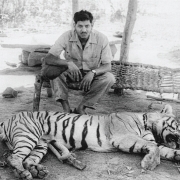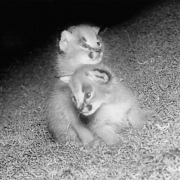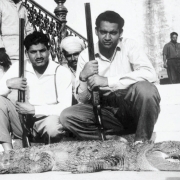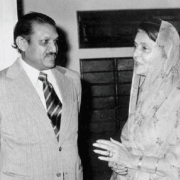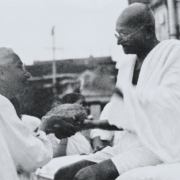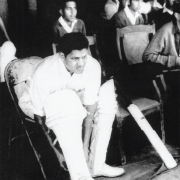
People
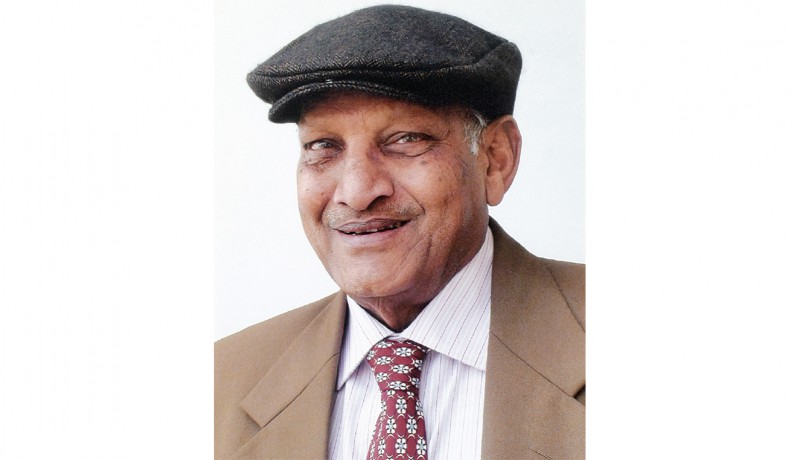
There’s no taming former cricket selector Kishan Rungta, who revealed his wild side in a recent book, writes Prakash Bhandari
Along the course of his fascinating life, Kishan Rungta has worn many hats. The 86 year-old from Jaipur has been a sportsman, chairman of the national cricket selection committee, a sports administrator, amateur photographer and—hold your breath—a master hunter.
His latest exploit played out far from the stomping grounds of the big cats but it is no less tame. Rungta recently launched a book titled Stalking Tigers on Foot, an account of his hunting expeditions and experiences, and memories of those wild and heady days. The 200-page hardcover, published by The Marine Sports, is choc-a-bloc with arresting and rare photographs clicked by him and his friends on the field.
While books on tigers are becoming commonplace, this one has some dramatic tales of big cats from 1950 to 1970. With over two dozen ‘kills’ to his name, Rungta points out that this was a time when hunting was legal. He underlines the fact that he laid down his rifle in 1967, well before tiger conservation became the need of the hour and the Wildlife Conservation Act was promulgated in 1973.
Rungta has explored the jungles of Africa but the forests of Ajabgarh and Bhangarh in Rajasthan were his favourite hunting grounds. His book is peppered with some hair-raising tales, like the time in 1961, when he shot two panthers while hunting in Samode village near Jaipur. “The panthers were on a killing spree, seizing goats and monkeys in the village,” he recounts. “I worked out a plan to kill them and took a great risk searching for them in the ravines. The ravine was almost 500 ft deep but I managed to descend into it and scalp them.”
But the huntsman was also an ace shooter of another kind: behind a camera lens. Rungta’s wonderful collection of wildlife photography has some rare shots of Queen Elizabeth and Prince Charles during their hunting expeditions when they were guests of Maharaja Sawai Man Singh and, later, with Maharani Gayatri Devi in Rajasthan. Among his prized shots of royals included in the book are images of the queen climbing a machan and eating her meals in the jungles of Ranthambhore, and a picture of a tiger killed by the royals.
Yet, the picture on the cover of Rungta’s book does not boast a tiger or lion as is typical of a tome of this nature—it is a stunning shot of a caracal (a type of wild cat), also called siah gosh in Rajasthan’s local parlance. Our huntsman says it is a tribute to the most challenging experience he’s ever had: rearing a pair of caracals in his Jaipur home.
He flips the pages to a chapter devoted to how he retrieved two caracals from the jungles of Ajabgarh in Alwar district of Rajasthan in the early ’60s. “We spotted them lying in a hollow in the jungle, their eyes not yet open,” he writes. Rungta and his team, who thought they were tiger cubs, wrapped them in a blanket to take them home to provide them food and comfort. On the way back, he met a tiger conservator friend, Kailash Sankhla, who told him they were caracals, not tiger cubs! “It was the first time I had seen caracal cubs. I brought them home and started taking care of them with tips from Sankhla.”
The cats brought out a soft side in our hardy hunter, who had a rare opportunity to observe caracal behaviour in captivity. “It’s a world record that a male-female pair of caracals lived in captivity for so long in an urban location,” he reveals.
“When they grew up, I made several attempts to get them to breed but they all failed.” When the cubs began to show distinct carnivorous traits, Rungta wondered what to do next. “Their instinct to attack was slowly becoming sharper. That’s when Sankhla advised I send the cubs to the Jaipur zoo, where a female caracal had already been housed. This was also a potential opportunity to breed the cats.” With a heavy heart, Rungta and his family at Man House, the family home in Jaipur, bade farewell to the cats after having tended to them for nine years. Sadly, the cats did not breed in captivity.
Rungta was known for hunting in a state where the activity was confined to kings and other royals, thakurs and zamindars, and high officials. He was often accompanied on his expeditions by his close friend Shanti Kumar Tholia from the famous Banji Tholia jeweller family of Jaipur.
“In 1963, Tholia and I were at Bhangarh forest and I was carrying my .423 rifle that was fully loaded. Neither of us was aware that the safety catch was unlocked. Tholia asked me to show him my weapon and I promptly handed it over to him. Assuming it was locked, he aimed at a barrel and fired. Oh God, I had such a narrow escape! I was in shock as the bullet whizzed past my face. Tholia was extremely sorry and apologised. The incident could have caused bad blood between us but it brought us closer. However, that day, I learnt the ‘safety first’ principle.”
Life through the lens
Fond of photography from an early age, Rungta captured some precious images of Mahatma Gandhi and other freedom fighters. The Rungtas were staunch nationalists and, like many other Marwari industrialists, at the forefront of the freedom movement. From his vantage point, the amateur photographer clicked scores of photographs of Gandhi in different moods and images during his prayer meetings.
He has nostalgic memories of the pre-Independence era, when Gandhi stayed at Birla House in Napean Sea Road in (then) Bombay, and came to his home to participate in prayer meetings held there. “I had a great passion for photography and had three cameras with me. I would click Gandhiji and immediately go to the photo studio to get the black-and-white film processed.”
Rungta’s memories also revolve around freedom fighters such as Sardar Patel, C Rajagopalachari, M A Jinnah and Khan Abdul Gaffar Khan who would frequent his home to meet Gandhi. “In the ’40s, when the great freedom fighter of Bihar, Jaiprakash Narayan, was wanted by the police, my family gave him shelter in our house at Napean Sea Road. Jaiprakash Narayan stayed in hiding in our house for several months.”
Clean bowled
Rungta was a multi-talented lad; when not clicking pictures, he was practising on the cricket pitch. A talented bowler and batsman, he played first-class cricket for Maharashtra and Rajasthan from 1953 to 1970. Rungta went on to become a national cricket selector, member of the Board of Control for Cricket in India and chairman of the Cricket Board’s Selection Committee.
Although cricket was his first love among sports, he also played tennis, badminton, billiards and golf. In fact, he got two grass courts developed at his residence in Jaipur, where several youngsters as well as national and international tennis legends such as the Amritraj brothers, Illie Nastase, Ion Tiriac and Akhtar Ali have played.
Rungta’s adventurous spirit drove him to break with tradition when he refused to join the family business. This was a huge step, considering he hailed from a high-profile family of industrialists close to the Maharaj of Jaipur, Sawai Man Singh. “I was meant to pursue the family business but indulged in activities opposed to the age-old traditions of the family. I was invited by Maharana Bhagwat Singh of Mewar [Udaipur] to play cricket and join wildlife safaris.” And what a turning point that was in his life. With a twinkle in his eye, he adds, “Despite my love for hunting, I am a strict vegetarian and teetotaller!”
A colourful personality who has lived life king-size, Rungta is unstoppable even if just four years shy of 90. He says his next project is a book on his experiences with cricket and other passions. We can’t wait!
Photos courtesy: Mukund Rungta Featured in Harmony — Celebrate Age Magazine October 2018
you may also like to read
-
For the love of Sanskrit
During her 60s, if you had told Sushila A that she would be securing a doctorate in Sanskrit in the….
-
Style sensation
Meet Instagram star Moon Lin Cocking a snook at ageism, this nonagenarian Taiwanese woman is slaying street fashion like….
-
Beauty and her beast
Meet Instagram star Linda Rodin Most beauty and style influencers on Instagram hope to launch their beauty line someday…..
-
Cooking up a storm!
Meet Instagram star Shanthi Ramachandran In today’s web-fuelled world, you can now get recipes for your favourite dishes at….



